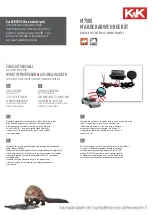
6
Dell PowerConnect W-Series
| ArubaOS 6.1 Quick Start Guide
Before you install APs in a mesh networking environment, you must do the following:
Define and configure the mesh cluster profile and mesh radio profile before configuring an AP to operate as a
mesh node. An AP configured for mesh is also known as a mesh node.
Provision one of the following mesh roles on the AP:
Mesh portal: The gateway between the wireless mesh network and the enterprise wired LAN.
Mesh point: APs that can provide traditional Dell WLAN services (such as client connectivity, intrusion
detection system (IDS) capabilities, user roles association, LAN-to-LAN bridging, and Quality of Service
(QoS) for LAN-to-mesh communication) to clients on one radio and perform mesh backhaul/network
connectivity on the other radio. Mesh points provides LAN-to-LAN bridging through their Ethernet
interfaces. It can now provide backhaul and access BSSIDs on the same radio.
For detailed provisioning guidelines, caveats, and instructions, see the “Secure Enterprise Mesh” chapter in the
Dell PowerConnect W-Series ArubaOS User Guide
.
Install the APs
Refer to the AP placement map generated by RF Plan to identify the locations in which to physically install your
APs. You can either connect the AP directly to a port on the controller, or connect the AP to another switch or
router that has Layer-2 or Layer-3 connectivity to the controller.
If the Ethernet port on the controller is an 802.3af Power over Ethernet (PoE) port, the AP automatically uses it
to power up. If a PoE port is not available, contact your Dell vendor to obtain an AC adapter for the AP.
Once an AP is connected to the network and powered up, it will automatically attempt to locate the controller.
You can view a list of all APs connected to the controller by accessing the Configuration > Wireless > AP
Installation page in the controller WebUI.
Figure 2
Viewing APs Connected to the Controller
An AP installed on the network advertises its default SSID. Wireless users can connect to this SSID, but will not
have access to the network until you configure authentication policies and user roles for your wireless users. For
complete details on authentication policies and user roles, refer to the
Dell PowerConnect W-Series ArubaOS User
Guide
.
Contacting Support
Table 4
Support Information
Web Site Support
Main Site
http://www.dell.com
Support Site
http://www.support.dell.com
Documentation Site
http://www.support.dell.com/manuals


























